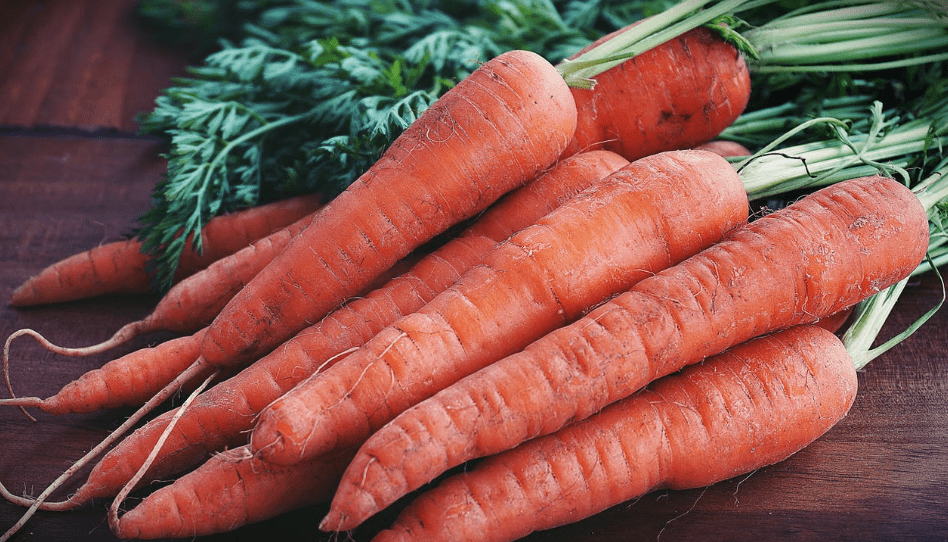Carrots most likely originated in Persia (Iran, Afghanistan), and were also most likely first cultivated in that region.
Carrots were originally grown for their leaves and seeds.
Carrots have been selectively bred for centuries resulting in the common commercial carrot of today.
Carrots are, also, must-have addition to the doomsday prepping list for bunker food.
How much does a carrot weigh?
| Carrot, Common | |||
|---|---|---|---|
| Small, average | about 5 1/2 inches length | 50g | 1.8oz |
| Medium, average | about 6 to 7 inches length | 61g | 2.2oz |
| Large, average | about 7 1/4 to 8 1/2 inches length | 73g | 2.6oz |
| Cup, Chopped | ? | 128g | 4.5oz |
| Cup, grated | ? | 110g | 3.9oz |
| Cup, Slices | ? | 122g | 4.3oz |
What You Need to Know About the Carrot
The carrot (Daucus carota) is a winter vegetable that belongs to the Apiaceae family. It is often considered the perfect vegetable because of the myriad of health benefits one gets from eating it, not to mention that the carrot is crunchy and tasty.
Do you know that the orange carrot you know today actually had different colors in the past? Read this article to learn about the colorful history of the carrot and its popular uses today. You can also check out https://bugoutbill.com/ to read a definitive guide on the must-haves survival gears.
History
The carrot was first cultivated as a food crop in Central Asia in the 10th century, although wild carrots have already been in existence in many temperate regions around the world before this era. Originally yellow and purple in color, the vegetable was carried by Arab conquerors to Spain during their expansion activities in the 12th century. It spread across North Africa, Europe, and the rest of Asia where further domestications in Spain and Germany in the 16th century turned this vegetable into orange. Through European colonisation, the carrot was introduced to the American continent.
Where the Carrot is Grown
The carrot can be grown in regions that have a dry, cool climate. For best growth, it should be planted in a loose, sandy loam soil during the spring and fall seasons. It can be grown in the ground, in individual beds, or in raised mounds. The carrot can be harvested from two to three months from sowing.
In 2019, the largest producer of carrots in the world is China with at least 21 million metric tons of carrots produced. It is followed by Uzbekistan and the United States.
Nutrition
The carrot is a good source of many vitamins and minerals including vitamin A (good for vision), biotin (good for metabolism), vitamin K1 or phylloquinone (good for blood coagulation and bone health), potassium (good for blood pressure control), and vitamin B6 (good for energy conversion).
A 100-gram carrot contains:
- Calories: 41
- Water: 88%
- Protein: 0.9 grams
- Carbs: 9.6 grams
- Sugar: 4.7 grams
- Fiber: 2.8 grams
- Fat: 0.2 grams
Types
The carrot comes in a variety of shapes, sizes, colors, and tastes. Below are the common types of the carrot.
- Nantes Carrot. The Nantes carrot has a long and cylindrical shape with blunt ends. Mild and sweet in flavor, it is popular among home gardeners because it can grow in many areas that other carrot varieties find difficult to grow in. Cultivars of the Nantes carrot include Scarlet Nantes, Napoli, Bolero, and White Satin.
- Imperator Carrot. The Imperator carrot grows longer than many other varieties and is a common choice for commercial carrot farmers because of its high sugar content. Its sub-varieties are long, straight and tapered carrots such as the Atomic Red, Cosmic Red, Tendersweet, and Autumn King.
- Chantenay Carrot. The Chantenay carrot is another variety that grows even in less ideal environment, just like the Nantes carrot. It is short and stout with light orange flesh. Its cultivars include Red Cored Chantenay, Royal Chantenay, and Hercules.
- Danver Carrot. The Danver carrot is an adaptable root vegetable that can be taken care of easily. It is medium-sized and was once a favorite choice for its flavor. Most commonly planted cultivars of this type are the Danvers 126 and Danvers Half-Long.
- Miniature Carrot. The miniature carrot are those harvested before they grow too large. Home gardeners often prefer this type because they can be planted in containers. Its varieties include Paris Market, Babette, Thumbelina, Little Finger, and Short ‘n Sweet.
Popular Uses
The carrot is popular as a vegetable addition to certain dishes, item in salads, snack, and as a raw vegetable. In particular, it is known for the following uses:
- Promoting Healthy Vision. The carrot contains vitamin A which helps in preventing dry eye. Its antioxidants lutein and zeaxanthin protect the retina and lens and are also known to improve eye health. According to the American Journal of Ophthalmology, eating two servings of carrots every week may lower the risk of glaucoma by up to 64 percent.
- Supporting Weight Loss. The carrot is known to be a healthy choice for a snack that gives very little amount of calories but high amount of nutrients. It can also easily make you feel full which keeps you from eating more than necessary.
- Improving immunity. The carrot is known to contain vitamin C and vitamin A which are important for boosting the immune system.
- Supporting Heart Health. Studies show that weight loss regimen involving carrots reduces the risk of coronary heart disease. It was also found out that the carrot can assist in regulating blood pressure.
The carrot is known for its high nutritional value, but just like other vegetables, some of its nutrients are lost in the cooking process. That is why it is preferred to consume the carrot in raw servings to fully benefit from its nutrients.
